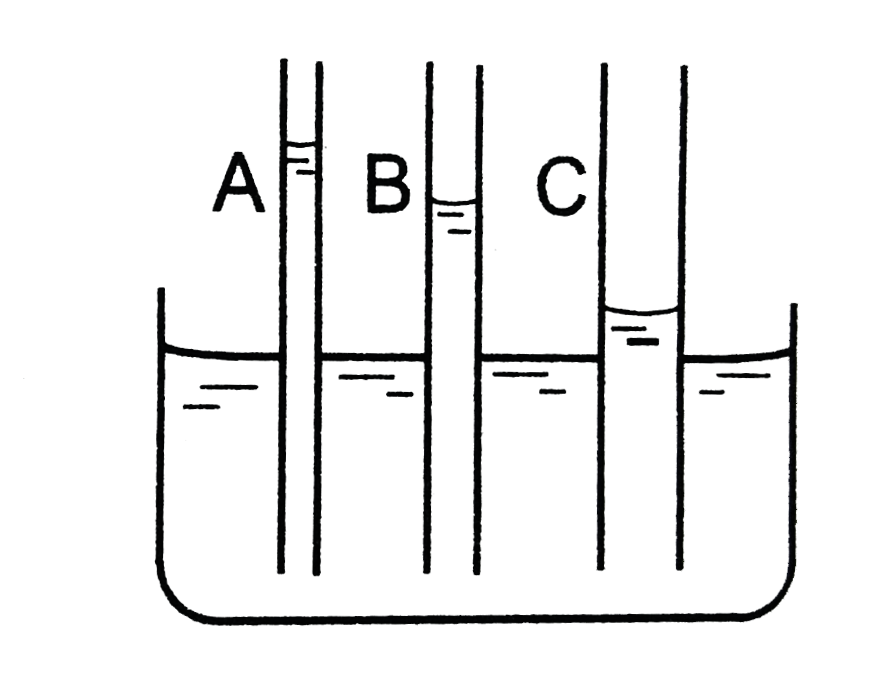A U-tube is supported with its limbs vertical and is partly filled with water. If internal diameters of the limbs are 1×10−2mand1×10−4m respectively, what will be the difference in height of water in the two limbs ? Surface tension of water is 0.07Nm−1 ?
To solve the problem of finding the difference in height of water in the two limbs of a U-tube, we can follow these steps:
Step 1: Identify the given data
- Internal diameter of limb 1, d1=1×10−2m
- Internal diameter of limb 2, d2=1×10−4m
- Surface tension of water, σ=0.07N/m
- Density of water, ρ=103kg/m3
- Acceleration due to gravity, g=9.8m/s2
Step 2: Calculate the radius of each limb
The radius r is half of the diameter:
- For limb 1:
r1=d12=1×10−22=0.5×10−2m
- For limb 2:
r2=d22=1×10−42=0.5×10−4m
Step 3: Use the formula for height difference due to surface tension
The height difference h in a capillary tube is given by:
h=2σcosθρgr
Since the angle of contact θ for water is 0∘, cosθ=1.
Step 4: Calculate the height of water in limb 1
Using the formula for limb 1:
h1=2σρgr1=2×0.07103×9.8×(0.5×10−2)
Calculating this gives:
h1=0.14103×9.8×0.005=0.1449≈0.002857m≈2.857×10−3m
Step 5: Calculate the height of water in limb 2
Using the formula for limb 2:
h2=2σρgr2=2×0.07103×9.8×(0.5×10−4)
Calculating this gives:
h2=0.14103×9.8×0.0005=0.144.9≈0.02857m≈2.857×10−2m
Step 6: Calculate the difference in height
The difference in height Δh is:
Δh=h2−h1=(2.857×10−2)−(2.857×10−3)=0.02857−0.002857≈0.025713m
Final Answer
The difference in height of water in the two limbs is approximately:
Δh≈0.0257mor25.7mm
- Internal diameter of limb 1, d1=1×10−2m
- Internal diameter of limb 2, d2=1×10−4m
- Surface tension of water, σ=0.07N/m
- Density of water, ρ=103kg/m3
- Acceleration due to gravity, g=9.8m/s2
The radius r is half of the diameter:
- For limb 1:
r1=d12=1×10−22=0.5×10−2m
- For limb 2:
r2=d22=1×10−42=0.5×10−4m
The height difference h in a capillary tube is given by:
h=2σcosθρgr
Since the angle of contact θ for water is 0∘, cosθ=1.
Using the formula for limb 1:
h1=2σρgr1=2×0.07103×9.8×(0.5×10−2)
Calculating this gives:
h1=0.14103×9.8×0.005=0.1449≈0.002857m≈2.857×10−3m
Using the formula for limb 2:
h2=2σρgr2=2×0.07103×9.8×(0.5×10−4)
Calculating this gives:
h2=0.14103×9.8×0.0005=0.144.9≈0.02857m≈2.857×10−2m
The difference in height Δh is:
Δh=h2−h1=(2.857×10−2)−(2.857×10−3)=0.02857−0.002857≈0.025713m
The difference in height of water in the two limbs is approximately:
Δh≈0.0257mor25.7mm
Similar Questions
A glass U-tube is such that the diameter of one limb is 3.0mm and that of the other is 6.0mm. The tube is inverted vertically with the open ends below the surface of water in a beaker. What is the difference between the height to which water rises in the two limbs? Surface tension of water is 0.07Nm−1. Assume that the angle of contact between water and glass is 0∘.
View SolutionThe capillaries shown in figure have inner radii 0.5 mm, 1.0 mm and 1.5 mm respectively. The liquid in the beaker is water. Find the heights of water level in the capillaries. The surface tension of water is 7.5×10−2Nm−1.

View SolutionCalculate the difference h in water levels in two commnicating capillary tube of radius 1mm and 1.5mm. Surface tension of water=0.07Nm−1

View SolutionTwo water pipes P and Q having diameters 2×10−2m and 4×10−2m, respectively, are joined in series with the main supply line of water. The velocity of water flowing in pipe P is
View SolutionIn a U-tube diamter of two limbs are 0.5 cm and 1 cm respectively and tube has filled with water (T=72dyne/cm) then liquid level difference between two limbs will be
View SolutionWhat is the difference of pressure between the inside and outside of a spherical drop of water of radius 1mm? Surface tension of water =7.2×10−2Nm−1
View SolutionA glass capillary tube of internal radius r=0.25mm is immersed in water. The top end of the tube projects by 2cm above the surface of water. At what angle does the liquid meet the tube? Surface tension of water =0.7Nm−1.
View SolutionCalculate the force required to take away a flat circular plate of radius 0.02m from the surface of water. The surface tension of water is 0.07Nm−1
View SolutionA water drop of radius 10−2 m is broken into 1000 equal droplets. Calculate the gain in surface energy. Surface tension of water is 0.075Nm−1
View SolutionTwo narrow bores of diameters 3.0mm and 6.0 mm are joined together to form a U-shaped tube open at both ends. If th U-tube contains water, what is the difference in its levels in the two limbs of the tube? Surface tension of water at the temperature of the experiment is 7.3×10−2Nm−1. Take the angle of contact to be zero. and density of water to be 1.0×103kg/m3.
(g=9.8ms−2)
View Solution
